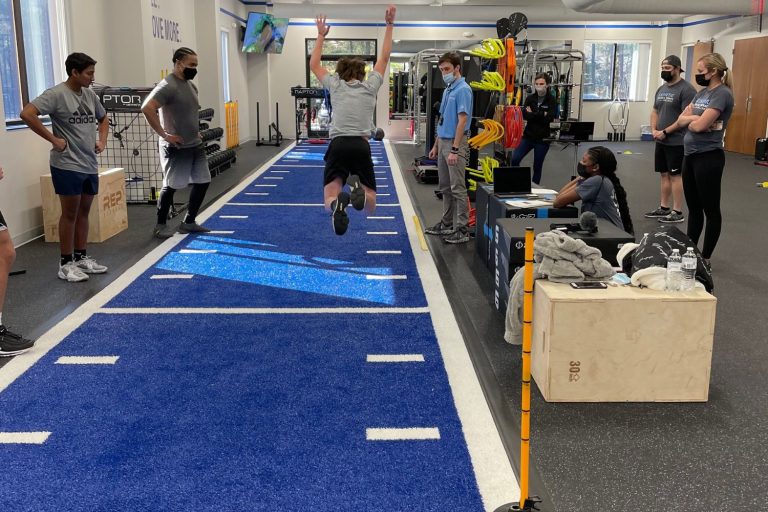

Get Rid of Those Tension Headaches for Good
Do you ever find that you have frequent headaches when you get stressed? Have you ever wondered why this happens? Tension headaches are typically the type of headaches that occur with stress. The pain from these headaches is frequently felt in the back and/or sides of the head, often spreading to the eye. Most people treat this type of pain with medication, but is this the best solution to address the underlying problem?
One of the most prevalent contributing factors to stress or tension headaches is posture. Whether we realize it or not, we tend to change our posture when we are stressed, resulting in pain. Let’s break posture down into two components: the head position, and the shoulder position.
The Head
What We Do Wrong: Poor posture of the head comes when we allow our heads to jut out in front of our bodies. This places excessive stress on muscles in the back of our neck and shoulders and can refer pain into the head.
What We Can Do To Improve Head Position: Chin tucks are a great exercise to help retrain your body to realize what normal head position is and to strengthening the muscles on the front of your neck that tend to get weak with poor posture. To complete these exercise, place two fingers on your chin and gently push your chin directly backward. Complete this 10-15 times throughout the day to help promote good habits.
The Shoulders
What We Do Wrong: Poor shoulder position occurs when we allow our shoulders to slouch forward in a rounded position. Like a forward head position, this also promotes stress and strain on the muscles in the shoulder and neck. With this poor position, the muscles that keep our shoulders in a good position become weak and don’t help us maintain our good posture.
What We Can Do To Improve Shoulder Position: Scapular retraction exercises work to use the weak muscles to pull your shoulder blades back and down into a good position. This will work to decrease stress on neck and shoulder muscles and reduce posture related pain. To complete this exercise, gently squeeze your shoulder blades back and down together, then relax them. Repeat this 10-15 times throughout the day to further your efforts to retrain your posture.
Posture is a habit and it takes time and conscious efforts to retrain your body to make good posture a habit. Most people experience worsened posture and resulting headaches when completing computer work or driving for extended periods of time.
Take breaks when completing these stressful activities to complete the chin tuck and scapular retraction exercises. Add in some relaxation techniques to help lower overall stress levels. Poor posture influences headaches, but also neck pain, jaw, pain, and shoulder pain. As a result, working to improve posture can help to reduce existing pain, but also prevent injury and pain from occurring.
If you have this pain and cannot manage it on your own, you should contact your physical therapist to evaluate the causes and triggers of your headaches and develop a strategy to help reduce the pain in a way that is tailored to you.
Please Share
categories
Recent Posts
categories

Get Rid of Those Tension Headaches for Good
Do you ever find that you have frequent headaches when you get stressed? Have you ever wondered why this happens? Tension headaches are typically the type of headaches that occur with stress. The pain from these headaches is frequently felt in the back and/or sides of the head, often spreading to the eye. Most people treat this type of pain with medication, but is this the best solution to address the underlying problem?
One of the most prevalent contributing factors to stress or tension headaches is posture. Whether we realize it or not, we tend to change our posture when we are stressed, resulting in pain. Let’s break posture down into two components: the head position, and the shoulder position.
The Head
What We Do Wrong: Poor posture of the head comes when we allow our heads to jut out in front of our bodies. This places excessive stress on muscles in the back of our neck and shoulders and can refer pain into the head.
What We Can Do To Improve Head Position: Chin tucks are a great exercise to help retrain your body to realize what normal head position is and to strengthening the muscles on the front of your neck that tend to get weak with poor posture. To complete these exercise, place two fingers on your chin and gently push your chin directly backward. Complete this 10-15 times throughout the day to help promote good habits.
The Shoulders
What We Do Wrong: Poor shoulder position occurs when we allow our shoulders to slouch forward in a rounded position. Like a forward head position, this also promotes stress and strain on the muscles in the shoulder and neck. With this poor position, the muscles that keep our shoulders in a good position become weak and don’t help us maintain our good posture.
What We Can Do To Improve Shoulder Position: Scapular retraction exercises work to use the weak muscles to pull your shoulder blades back and down into a good position. This will work to decrease stress on neck and shoulder muscles and reduce posture related pain. To complete this exercise, gently squeeze your shoulder blades back and down together, then relax them. Repeat this 10-15 times throughout the day to further your efforts to retrain your posture.
Posture is a habit and it takes time and conscious efforts to retrain your body to make good posture a habit. Most people experience worsened posture and resulting headaches when completing computer work or driving for extended periods of time.
Take breaks when completing these stressful activities to complete the chin tuck and scapular retraction exercises. Add in some relaxation techniques to help lower overall stress levels. Poor posture influences headaches, but also neck pain, jaw, pain, and shoulder pain. As a result, working to improve posture can help to reduce existing pain, but also prevent injury and pain from occurring.
If you have this pain and cannot manage it on your own, you should contact your physical therapist to evaluate the causes and triggers of your headaches and develop a strategy to help reduce the pain in a way that is tailored to you.
Please Share









